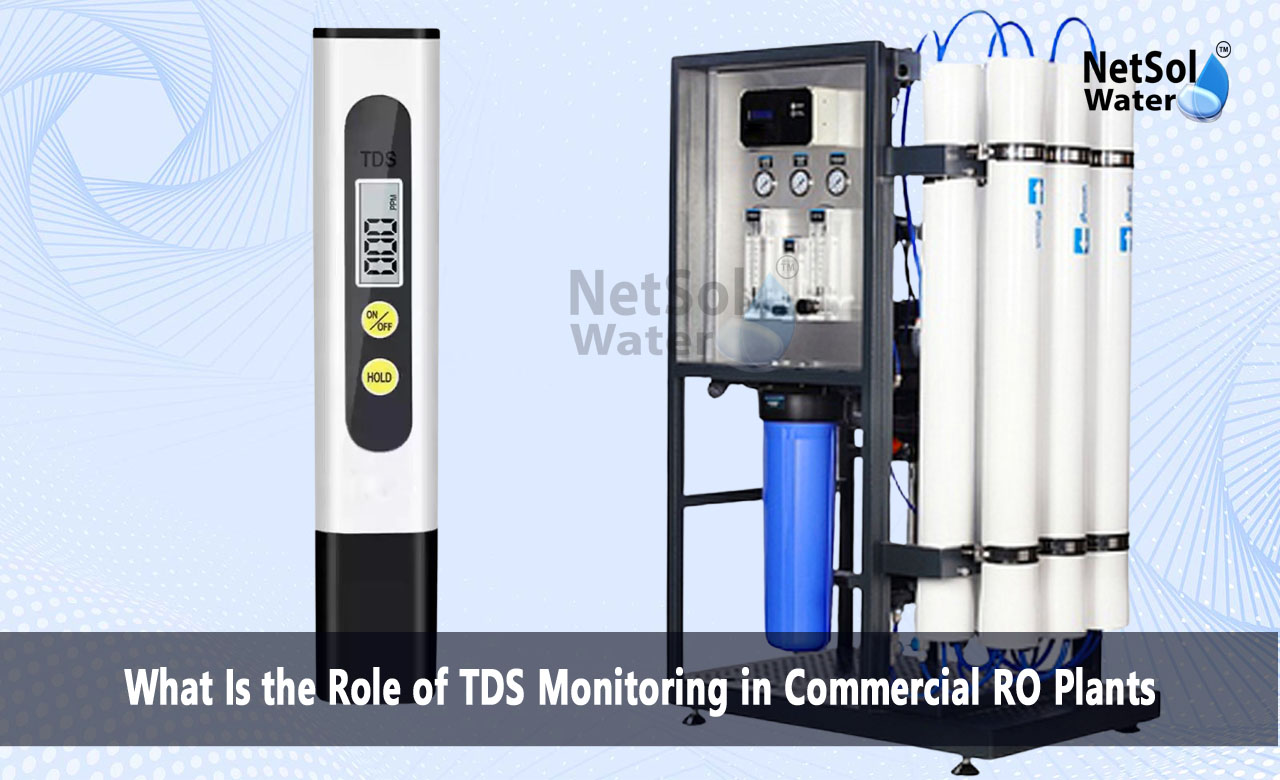What Is the Role of TDS Monitoring in Commercial RO Plants?
Commercial RO plants are applied very commonly in industries, institutions, and commercial complexes for purifying water and removing unwanted impurities. Out of the many parameters that decide water quality in RO plants, TDS, or Total Dissolved Solids, is a major one. TDS measurement is extremely necessary to ensure that purified water is safe, effective to use, and of standard.
We will observe the role of TDS monitoring in commercial RO plants, why is it necessary, how it is implemented, and what are its benefits in maintaining system performance and safety of water.
What is TDS?
TDS stands for Total Dissolved Solids, i.e., the total of inorganic salts and organic substances dissolved in water. They are calcium, magnesium, sodium, potassium, chlorides, sulfates, and so on. TDS may be expressed in milligrams per liter (mg/L) or parts per million (ppm).
High TDS levels, on the other hand, cause water to have a metallic or salty taste, scales equipment and pipes, and may not be suitable for drinking or industrial use. Low TDS, on the other hand, indicates effective filtration.
The Role of TDS Monitoring in Commercial RO Plants
Ensuring Consistent Water Quality
One of the major roles of TDS monitoring is to ensure that product water from the RO plant is always meeting quality standards. Regardless of whether the water gets applied in consumptions, process uses, or in cleaning, balanced and acceptable levels of TDS are critical.
When the TDS level of the product water starts to increase, it typically indicates membrane failure or fouling. Regular monitoring allows for early recognition and quick response.
Protection of Process and Equipment
Water-using processes that use water in boilers, cooling towers, manufacturing, or laboratories rely on proper water quality. High TDS water may cause scaling, corrosion, or product quality issues. Proper monitoring of TDS prevents equipment damage and maintains continuity of operations.
This is an important aspect of TDS monitoring in business RO plants since it protects both water systems and processes dependent upon them.
RO System Performance Measurement
TDS meters may be placed before and after the RO membrane. Comparing TDS of input water and output water gives you the rejection rate — a straightforward measure of how well the membrane is functioning.
A good RO plant should reject 95%–99% of TDS. If it falls below this, it means the membrane is clogged, has deteriorated, or is faulty. Monitoring on a regular basis enables us to track this decline and arrange maintenance or replacement.
Enforcing Regulatory Compliance
Various industries, including food, beverage, and pharmaceutical, must comply with water quality standards set by regulatory agencies. One of the parameters in such standards is TDS.
Through the installation of TDS monitoring systems and keeping proper records, industries can establish compliance during inspections or audits. This prevents not only the imposition of fines but also creates confidence with customers as well as regulators.
Techniques for TDS Monitoring
There are two primary ways of TDS monitoring in commercial RO plants:
Manual Monitoring: The operators sample water and take readings by means of portable TDS meters. For negligible cost, it is a labor-intensive method and can miss rapid water quality variations.
Online/Automatic TDS Monitoring: Digital sensors are connected to the RO control panel in current industrial applications. They sense real-time TDS and generate an alarm if levels cross the set limit. It is highly effective for continuous monitoring and instant response.
What If TDS Monitoring Is Neglected?
Neglecting TDS monitoring in commercial RO plants can lead to:
· Sudden membrane failure
· Poor quality water and customer complaints
· Damage to the machine with high-TDS water
· Regulatory violations and fines
· Higher operating costs from surprise repairs
Apparently, ignoring this simple parameter has some serious problems.
Optimum TDS Monitoring Practices
To get the most benefit out of TDS monitoring, employ these practices:
· Daily calibrate sensors to maintain accuracy
· Daily record TDS values to identify trends
· Set up alert levels to identify changes before they become large
· Monitor TDS input and output to identify performance
· Train operators in interpreting and acting upon TDS readings
By doing this, you enhance the general dependability of your RO plant.
Conclusion
The role of TDS monitoring in commercial RO plants is essential to guarantee superior water quality, system wellness, and avoidance of operating danger. It is your insurance — constantly checking the efficacy of the RO process and helping you make timely adjustments.
Whether manually or by automation, monitoring TDS closely means your business RO plant keeps on providing pure, safe, and consistent water day in and day out.
Do you need an advice or assistance on selecting the best water and waste water treatment unit? We have solutions for all your problems!
Let us know your problem, our experts will make sure that it goes away.
For an assistance or related query,
Call on +91-9650608473 Or write us at enquiry@netsolwater.com



